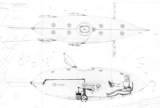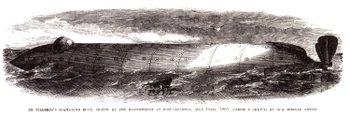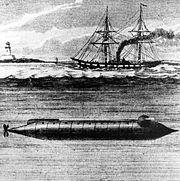
Brutus de Villeroi
Encyclopedia
Brutus de Villeroi was a French
engineer of the 19th century, born as Brutus Villeroi (he added the aristocratic "de" in his later years) in the city of Tours
and soon moved to Nantes
, who developed some of the first operational submarine
s, and the first submarine of the United States Navy
, the Alligator
in 1862.
 In 1833, de Villeroi completed a small submarine, possibly named "Nautilus" in reference to the 1800 submarine
In 1833, de Villeroi completed a small submarine, possibly named "Nautilus" in reference to the 1800 submarine
created by Robert Fulton
.
The submarine was 10' 6" long by 27" high by 25" wide and displaced about six tons when submerged. She was equipped with eight dead-lights on top to provide interior light, and a top hatch with a retractable conning tower for surface navigation. For propulsion, she had three sets of duck-foot paddles and a large rudder. She was also equipped with a hatches with leather seals in order to make some manipulations outside of hull, a small ballast system with a lever and piston, and a 50 lb anchor
. The ship had a complement of three men.
This submarine was demonstrated at Fromentine, Noirmoutier, near Nantes, France, in 1833, and later to representatives of the Kingdom of the Netherlands
in 1837.
De Villeroi tried several times to sell his submarine designs to the French Navy
(1832, 1855 and 1863), but he was apparently turned down every time.
In 1842, Brutus de Villeroi was reputedly a professor for drawing and mathematics at the Saint-Donatien Junior Seminary in Nantes, where Jules Verne
was also a student. He may have inspired Verne's conceptual design for the Nautilus
in Twenty Thousand Leagues Under the Sea
, although no evidence for Villeroi's employment at Saint-Donatien has yet been found, and no direct link between the two men has ever been established.
in the United States
, where he developed several submarines. He is recorded in a 1860 American census, where his occupation is described as "natural genius
".
 His first American submarine was built for salvage purposes, and it gained fame when it was seized on May 16, 1861, by the suspicious Philadelphia police as it sailed up the Delaware River
His first American submarine was built for salvage purposes, and it gained fame when it was seized on May 16, 1861, by the suspicious Philadelphia police as it sailed up the Delaware River
. Commander Henry K. Hoff, USN, wrote a report to Captain S.F. Dubont, Commanding Officer of Naval Station Philadelphia, describing the performance of the submarine and its interest to the Navy (Full text ):
Brutus de Villeroi's next ship, the USS Alligator, would be largely inspired from this design.

 Brutus de Villeroi proposed a submarine design to the United States Navy
Brutus de Villeroi proposed a submarine design to the United States Navy
, to counter the threat of Confederate States Navy
ironclad warship
s. The Navy signed a contract with de Villeroi in autumn 1861, for the submarine to be built in 40 days, for a sum of US $
14,000. The ship became the US Navy's first submarine
, the Alligator. It was never officially commissioned and therefore does not have the "USS" prefix.
De Villeroi supervised the first phased of the construction in Philadelphia, but was progressively evicted from the project as he opposed some modifications to his design.
It was the first submarine to be ordered and built for the US Navy, the first to have a diver's lockout chamber, the first to have on-board air compressors for air renewal and diver support, the first to have an air-purifying system, the first to have electrically detonated limpet mines. It was designed primarily to launch divers, who could then plant bombs under surface ships or perform operations underwater.
, but it was rejected as impractical and poorly researched. The French Navy was also already working on another design, Plongeur
, with a compressed air engine, which was launched in 1863.
De Villeroi remained in the United States and died of chronic bronchitis
in 1874. He was buried alongside his wife, Eulalie de Villeroi, in Rosedale Memorial Park, in Bensalem, Pennsylvania.
France in the nineteenth century
The History of France from 1789 to 1914 extends from the French Revolution to World War I and includes:*French Revolution *French First Republic *First French Empire under Napoleon...
engineer of the 19th century, born as Brutus Villeroi (he added the aristocratic "de" in his later years) in the city of Tours
Tours
Tours is a city in central France, the capital of the Indre-et-Loire department.It is located on the lower reaches of the river Loire, between Orléans and the Atlantic coast. Touraine, the region around Tours, is known for its wines, the alleged perfection of its local spoken French, and for the...
and soon moved to Nantes
Nantes
Nantes is a city in western France, located on the Loire River, from the Atlantic coast. The city is the 6th largest in France, while its metropolitan area ranks 8th with over 800,000 inhabitants....
, who developed some of the first operational submarine
Submarine
A submarine is a watercraft capable of independent operation below the surface of the water. It differs from a submersible, which has more limited underwater capability...
s, and the first submarine of the United States Navy
United States Navy
The United States Navy is the naval warfare service branch of the United States Armed Forces and one of the seven uniformed services of the United States. The U.S. Navy is the largest in the world; its battle fleet tonnage is greater than that of the next 13 largest navies combined. The U.S...
, the Alligator
Alligator
An alligator is a crocodilian in the genus Alligator of the family Alligatoridae. There are two extant alligator species: the American alligator and the Chinese alligator ....
in 1862.
Villeroi's first submarine (1833)

Nautilus (1800 submarine)
Nautilus, first tested in 1800, is often considered the first practical submarine, though preceded by Cornelius Drebbel's of 1620.-Background:...
created by Robert Fulton
Robert Fulton
Robert Fulton was an American engineer and inventor who is widely credited with developing the first commercially successful steamboat...
.
The submarine was 10' 6" long by 27" high by 25" wide and displaced about six tons when submerged. She was equipped with eight dead-lights on top to provide interior light, and a top hatch with a retractable conning tower for surface navigation. For propulsion, she had three sets of duck-foot paddles and a large rudder. She was also equipped with a hatches with leather seals in order to make some manipulations outside of hull, a small ballast system with a lever and piston, and a 50 lb anchor
Anchor
An anchor is a device, normally made of metal, that is used to connect a vessel to the bed of a body of water to prevent the vessel from drifting due to wind or current. The word derives from Latin ancora, which itself comes from the Greek ἄγκυρα .Anchors can either be temporary or permanent...
. The ship had a complement of three men.
This submarine was demonstrated at Fromentine, Noirmoutier, near Nantes, France, in 1833, and later to representatives of the Kingdom of the Netherlands
Kingdom of the Netherlands
The Kingdom of the Netherlands is a sovereign state and constitutional monarchy with territory in Western Europe and in the Caribbean. The four parts of the Kingdom—Aruba, Curaçao, the Netherlands, and Sint Maarten—are referred to as "countries", and participate on a basis of equality...
in 1837.
De Villeroi tried several times to sell his submarine designs to the French Navy
French Navy
The French Navy, officially the Marine nationale and often called La Royale is the maritime arm of the French military. It includes a full range of fighting vessels, from patrol boats to a nuclear powered aircraft carrier and 10 nuclear-powered submarines, four of which are capable of launching...
(1832, 1855 and 1863), but he was apparently turned down every time.
In 1842, Brutus de Villeroi was reputedly a professor for drawing and mathematics at the Saint-Donatien Junior Seminary in Nantes, where Jules Verne
Jules Verne
Jules Gabriel Verne was a French author who pioneered the science fiction genre. He is best known for his novels Twenty Thousand Leagues Under the Sea , A Journey to the Center of the Earth , and Around the World in Eighty Days...
was also a student. He may have inspired Verne's conceptual design for the Nautilus
Nautilus (Verne)
The Nautilus is the fictional submarine featured in Jules Verne's novels Twenty Thousand Leagues Under the Sea and The Mysterious Island . Verne named the Nautilus after Robert Fulton's real-life submarine Nautilus...
in Twenty Thousand Leagues Under the Sea
Twenty Thousand Leagues Under the Sea
Twenty Thousand Leagues Under the Sea is a classic science fiction novel by French writer Jules Verne published in 1870. It tells the story of Captain Nemo and his submarine Nautilus as seen from the perspective of Professor Pierre Aronnax...
, although no evidence for Villeroi's employment at Saint-Donatien has yet been found, and no direct link between the two men has ever been established.
United States career
During the late 1850s, Brutus de Villeroi went to Philadelphia, PennsylvaniaPennsylvania
The Commonwealth of Pennsylvania is a U.S. state that is located in the Northeastern and Mid-Atlantic regions of the United States. The state borders Delaware and Maryland to the south, West Virginia to the southwest, Ohio to the west, New York and Ontario, Canada, to the north, and New Jersey to...
in the United States
United States
The United States of America is a federal constitutional republic comprising fifty states and a federal district...
, where he developed several submarines. He is recorded in a 1860 American census, where his occupation is described as "natural genius
Genius
Genius is something or someone embodying exceptional intellectual ability, creativity, or originality, typically to a degree that is associated with the achievement of unprecedented insight....
".
Salvage submarine (1861)

Delaware River
The Delaware River is a major river on the Atlantic coast of the United States.A Dutch expedition led by Henry Hudson in 1609 first mapped the river. The river was christened the South River in the New Netherland colony that followed, in contrast to the North River, as the Hudson River was then...
. Commander Henry K. Hoff, USN, wrote a report to Captain S.F. Dubont, Commanding Officer of Naval Station Philadelphia, describing the performance of the submarine and its interest to the Navy (Full text ):
- "In justice to Mr. De Villeroi we should state that the boat in question was constructed for salvage purposes and not for war uses, (for the latter, he proposes if his services are accepted by the Government to construct another on a larger scale whose greater capacity would afford additional facilities for the maneuvers of the men while it would also be provided with greatly increased power of propulsion) so that in the experiment we have considered the machine employed simple as a model to demonstrate the principles to be established by the inventor." (Letter by Henry K. Hoff, Commander, 1861)
Brutus de Villeroi's next ship, the USS Alligator, would be largely inspired from this design.
The Alligator (1862)


United States Navy
The United States Navy is the naval warfare service branch of the United States Armed Forces and one of the seven uniformed services of the United States. The U.S. Navy is the largest in the world; its battle fleet tonnage is greater than that of the next 13 largest navies combined. The U.S...
, to counter the threat of Confederate States Navy
Confederate States Navy
The Confederate States Navy was the naval branch of the Confederate States armed forces established by an act of the Confederate Congress on February 21, 1861. It was responsible for Confederate naval operations during the American Civil War...
ironclad warship
Ironclad warship
An ironclad was a steam-propelled warship in the early part of the second half of the 19th century, protected by iron or steel armor plates. The ironclad was developed as a result of the vulnerability of wooden warships to explosive or incendiary shells. The first ironclad battleship, La Gloire,...
s. The Navy signed a contract with de Villeroi in autumn 1861, for the submarine to be built in 40 days, for a sum of US $
United States dollar
The United States dollar , also referred to as the American dollar, is the official currency of the United States of America. It is divided into 100 smaller units called cents or pennies....
14,000. The ship became the US Navy's first submarine
Submarine
A submarine is a watercraft capable of independent operation below the surface of the water. It differs from a submersible, which has more limited underwater capability...
, the Alligator. It was never officially commissioned and therefore does not have the "USS" prefix.
De Villeroi supervised the first phased of the construction in Philadelphia, but was progressively evicted from the project as he opposed some modifications to his design.
It was the first submarine to be ordered and built for the US Navy, the first to have a diver's lockout chamber, the first to have on-board air compressors for air renewal and diver support, the first to have an air-purifying system, the first to have electrically detonated limpet mines. It was designed primarily to launch divers, who could then plant bombs under surface ships or perform operations underwater.
Later life
In 1863, Brutus de Villeroi, after a dispute with his American associates, proposed his submarine design to the government of Napoleon III of FranceNapoleon III of France
Louis-Napoléon Bonaparte was the President of the French Second Republic and as Napoleon III, the ruler of the Second French Empire. He was the nephew and heir of Napoleon I, christened as Charles Louis Napoléon Bonaparte...
, but it was rejected as impractical and poorly researched. The French Navy was also already working on another design, Plongeur
Plongeur
Plongeur was a French submarine launched on 16 April 1863. She was the first submarine in the world to be propelled by mechanical power....
, with a compressed air engine, which was launched in 1863.
De Villeroi remained in the United States and died of chronic bronchitis
Chronic bronchitis
Chronic bronchitis is a chronic inflammation of the bronchi in the lungs. It is generally considered one of the two forms of chronic obstructive pulmonary disease...
in 1874. He was buried alongside his wife, Eulalie de Villeroi, in Rosedale Memorial Park, in Bensalem, Pennsylvania.

